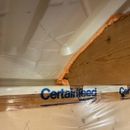Preventing ice damming
Hey all again. Painfully slow progress on my home reno. I’m in Northern Ohio in zone 5. I’ve foam sealed in vent baffles and have a thick butyl membrane under my new standing seam metal roof but like a lot of houses around here from the 60s and 70s I have a very low sloped roof. At some points it seems to only be a distance a maybe 3 inches between the top plate and the vent baffle. I wanted to just blow in cellulose or but rockwool batts in (less likely due to difficulty) but would you guys suggest I use a froth pak kit to spray foam all of those tight spaces and just hope for the best? I know that’s what it says would be my best option at this point according to articles on here but just wanted to see if anyone has had a similar experience in zone 5 and if the cellulose and air sealing will suffice.
GBA Detail Library
A collection of one thousand construction details organized by climate and house part










Replies
Cellulose is better about limiting airflow compared to fiberglass or mineral wool, so it would be a better option here if you go the loose fill only route. If you have an inaccessible top plate due to the very low slope of the roof, then spray foam is probably your only practical option for a good air sealing job if you can’t do the work from underneath in the interior living spaces. Keep in mind that even with spray foam, tight spaces can make it difficult to get a good application if you can’t get in close enough to point the spray foam gun properly.
Bill
I think the canned foam/vent baffles will be able to air seal to the outside enough to prevent windwash and hopefully get the most out of the small amount of r value I’ll have. Like I said I only have like 3 inches to work with at the smallest part. Hopefully I can make it a little more insulated from the outside when I redo my soffits in the future. I will be air sealing from the inside with a layer of certainteed around the perimeter of the ceiling made to be continuous with the layer on the walls. I’ll just glue or foam it down to the top side of the ceiling drywall. Do you think just a few inches of cellulose will be ok at that smallest point? I was hoping to avoid on site spray foam. Thanks.
You don’t have to use spray foam if you air seal the old fashioned way with canned foam and caulk. The only advantage to spray foam here would be if you had minimal accessibility to the top plate, so if you can get at that from underneath then that gives you other options.
I’m not sure what “a layer of certainteed” is here as they make many products. Maybe you mean MemBrain? You can make MemBrain an air barrier, I’ve even done it myself. It’s usually easiest to use the drywall itself as the air barrier though. I like to use a bead of polyurethane sealant around the perimeter as the drywall goes up to seal things. It’s pretty quick and easy to do, especially if you use one of the fancy battery powered caulk guns.
Bill
I guess my thinking was since there’s only 3inches of space between the top plate and vent baffle/roof decking, I’d need to use spray foam to get the most r-value I could to prevent ice damming. If blown in cellulose will suffice I’ll do that! And yes, Membrain was the product I was referring to. Once the ceiling drywall is up I won’t be able to seal up that joint between the wall and the ceiling due to how Low the slope is. I was thinking I could just extend the Membrain a few inches overlapping the wall and then a few feet in from the perimeter of the ceiling. Then one the ceiling drywall goes up I could tape or caulk or foam it to the attic side of the ceiling drywall from the top and it would be all air tight if that makes sense.
"Extend the Membrain a few inches overlapping the wall and then a few feet in from the perimeter of the ceiling"
That is definitely a good way to air seal. Membrane is pretty easy to tear, depending on who is doing the drywall install and how much care they take, something beefier like 6 mil poly might be better here.
Once the ceiling is up, I would also do a bit of air leakage testing. The best way to reduce ice damming is to limit air leaks. This way you can always touch up the wall top plates from the attic with some SPF before the insulation goes in if needed.
Attached with clips along the roof’s edge in a zigzag pattern, heated cables help prevent ice dams that lift shingles and cause leaks. This solution allows you to equalize your roof’s temperature by heating it from the outside instead of blowing in cold air from the inside (as we mention next in “Fast Fixes”). Just be sure to install the cables before bad weather hits.
Heating cables use a suprising amount of energy though, which represents a sizeable ongoing cost. Air sealing the attic space will often accomplish about the same, but with no ongoing expense. I'd consider heating cables a last resort here.
Bill